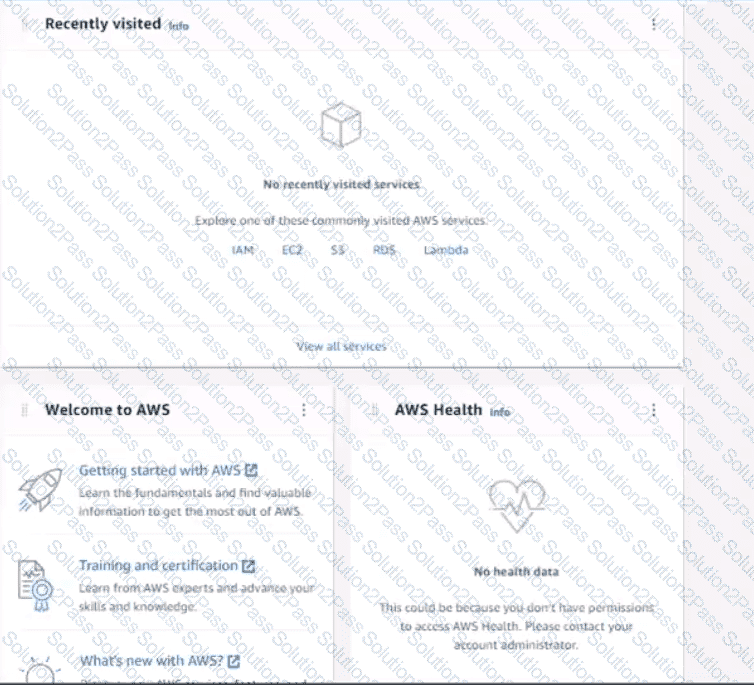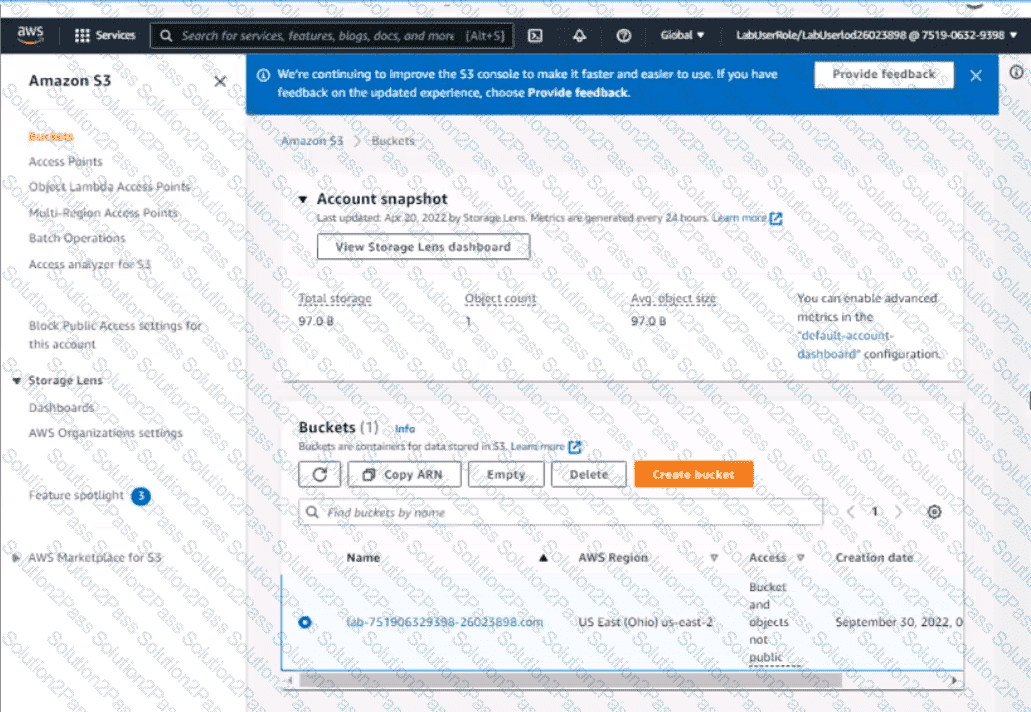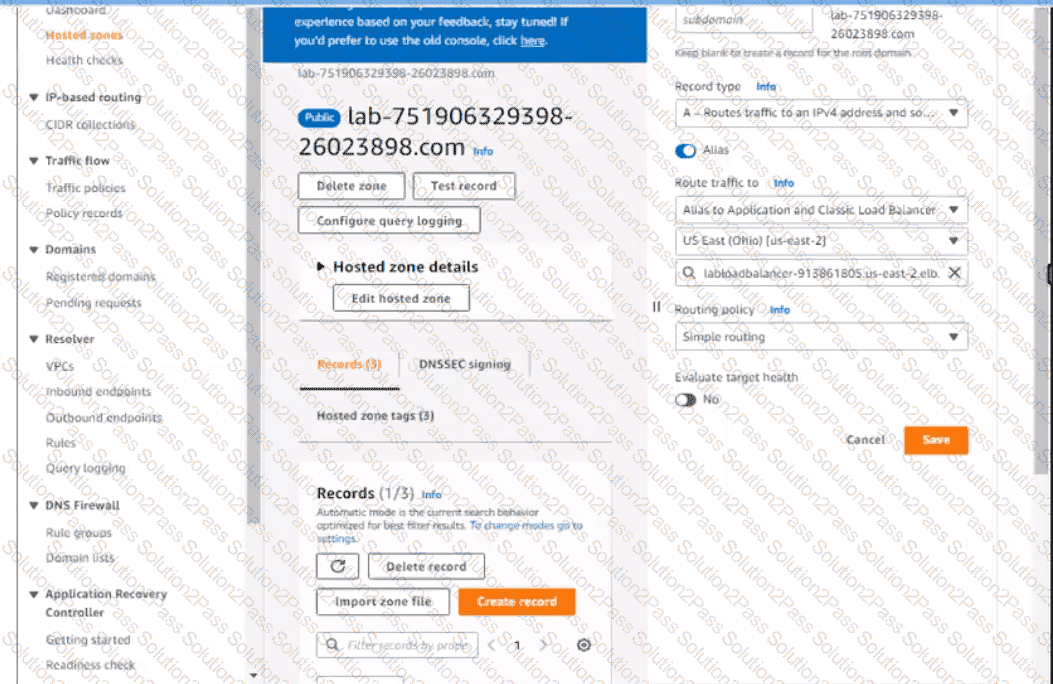SOA-C02 Amazon Web Services AWS Certified SysOps Administrator - Associate (SOA-C02) Free Practice Exam Questions (2025 Updated)
Prepare effectively for your Amazon Web Services SOA-C02 AWS Certified SysOps Administrator - Associate (SOA-C02) certification with our extensive collection of free, high-quality practice questions. Each question is designed to mirror the actual exam format and objectives, complete with comprehensive answers and detailed explanations. Our materials are regularly updated for 2025, ensuring you have the most current resources to build confidence and succeed on your first attempt.
If your AWS Management Console browser does not show that you are logged in to an AWS account, close the browser and relaunch the
console by using the AWS Management Console shortcut from the VM desktop.
If the copy-paste functionality is not working in your environment, refer to the instructions file on the VM desktop and use Ctrl+C, Ctrl+V or Command-C , Command-V.
Configure Amazon EventBridge to meet the following requirements.
1. use the us-east-2 Region for all resources,
2. Unless specified below, use the default configuration settings.
3. Use your own resource naming unless a resource
name is specified below.
4. Ensure all Amazon EC2 events in the default event
bus are replayable for the past 90 days.
5. Create a rule named RunFunction to send the exact message every 1 5 minutes to an existing AWS Lambda function named LogEventFunction.
6. Create a rule named SpotWarning to send a notification to a new standard Amazon SNS topic named TopicEvents whenever an Amazon EC2
Spot Instance is interrupted. Do NOT create any topic subscriptions. The notification must match the following structure:
Input Path:
{“instance” : “$.detail.instance-id”}
Input template:
“ The EC2 Spot Instance
You need to update an existing AWS CloudFormation stack. If needed, a copy to the CloudFormation template is available in an Amazon SB bucket named cloudformation-bucket
1. Use the us-east-2 Region for all resources.
2. Unless specified below, use the default configuration settings.
3. update the Amazon EQ instance named Devinstance by making the following changes to the stack named 1700182:
a) Change the EC2 instance type to us-east-t2.nano.
b) Allow SSH to connect to the EC2 instance from the IP address range
192.168.100.0/30.
c) Replace the instance profile IAM role with IamRoleB.
4. Deploy the changes by updating the stack using the CFServiceR01e role.
5. Edit the stack options to prevent accidental deletion.
6. Using the output from the stack, enter the value of the Prodlnstanceld in the text box below:
A webpage is stored in an Amazon S3 bucket behind an Application Load Balancer (ALB). Configure the SS bucket to serve a static error page in the event of a failure at the primary site.
1. Use the us-east-2 Region for all resources.
2. Unless specified below, use the default configuration settings.
3. There is an existing hosted zone named lab-
751906329398-26023898.com that contains an A record with a simple routing policy that routes traffic to an existing ALB.
4. Configure the existing S3 bucket named lab-751906329398-26023898.com as a static hosted website using the object named index.html as the index document
5. For the index-html object, configure the S3 ACL to allow for public read access. Ensure public access to the S3 bucketjs allowed.
6. In Amazon Route 53, change the A record for domain lab-751906329398-26023898.com to a primary record for a failover routing policy. Configure the record so that it evaluates the health of the ALB to determine failover.
7. Create a new secondary failover alias record for the domain lab-751906329398-26023898.com that routes traffic to the existing 53 bucket.
The SysOps administrator must restart the web server if specific errors are detected in logs on EC2 instances behind a load balancer.
Options (Select THREE):
A SysOps administrator is provisioning an Amazon Elastic File System (Amazon EFS) file system to provide shared storage across multiple Amazon EC2 instances The instances all exist in the same VPC across multiple Availability Zones. There are two instances In each Availability Zone. The SysOps administrator must make the file system accessible to each instance with the lowest possible latency.
Which solution will meet these requirements?
A company has a new requirement stating that all resources In AWS must be tagged according to a set policy.
Which AWS service should be used to enforce and continually Identify all resources that are not in compliance with the policy?
A company is using Amazon CloudFront to serve static content for its web application to its users. The CloudFront distribution uses an existing on-premises website as a custom origin.
The company requires the use of TLS between CloudFront and the origin server. This configuration has worked as expected for several months. However, users are now experiencing HTTP 502 (Bad Gateway) errors when they view webpages that include content from the CloudFront distribution.
What should a SysOps administrator do to resolve this problem?
A SysOps administrator is evaluating Amazon Route 53 DNS options to address concerns about high availability for an on-premises website. The website consists of two servers: a primary active server and a secondary passive server. Route 53 should route traffic to the primary server if the associated health check returns 2xx or 3xx HTTP codes. All other traffic should be directed to the secondary passive server. The failover record type, set ID. and routing policy have been set appropriately for both primary and secondary servers.
Which next step should be taken to configure Route 53?
A user working in the Amazon EC2 console increased the size of an Amazon Elastic Block Store (Amazon EBS) volume attached to an Amazon EC2 Windows instance. The change is not reflected in the file system.
What should a SysOps administrator do to resolve this issue?
A company has several member accounts that are in an organization in AWS Organizations. The company recently discovered that administrators have been using account root user credentials. The company must prevent the administrators from using root user credentials to perform any actions on Amazon EC2 instances.
What should a SysOps administrator do to meet this requirement?
A SysOps administrator has created an AWS Service Catalog portfolio and has shared the portfolio with a second AWS account in the company. The second account is controlled by a different administrator.
Which action will the administrator of the second account be able to perform?
An Amazon S3 Inventory report reveals that more than 1 million objects in an S3 bucket are not encrypted These objects must be encrypted, and all future objects must be encrypted at the time they are written
Which combination of actions should a SysOps administrator take to meet these requirements? (Select TWO )
A company is using an Amazon CloudWatch alarm lo monitor the FreeLocalStorage metric for an Amazon Aurora PostgreSQL production database The alarm goes into ALARM state and indicates that the database is running low on temporary storage. A SysOps administrator discovers that a weekly report is using most of the temporary storage that is currently allocated.
What should the SysOps administrator do to solve this problem?
A company has an Amazon EC2 instance that runs Windows Server 2019. An encrypted Amazon Elastic Block Store (Amazon EBS) volume is attached to the instance as the main boot volume. The company has lost the ability to use Remote Desktop Protocol (RDP) to connect to the instance.
The company needs to back up the instance. Before the backup, a SysOps administrator must change local Windows Firewall settings to fix the RDP connectivity issue.
The SysOps administrator stops the instance.
What should the SysOps administrator do next to regain access to the instance?
A company that uses AWS Organizations has an organization that contains several AWS accounts. A SysOps administrator needs to implement controls to prevent an account from leaving the organization.
Which solution will meet these requirements?
A company recently migrated its application to a VPC on AWS. An AWS Site-to-Site VPN connection connects the company’s on-premises network to the VPC. The application retrieves customer data from another system that resides on premises. The application uses an on-premises DNS server to resolve domain records. After the migration, the application is not able to connect to the customer data because of name resolution errors.
Which solution will give the application the ability to resolve the internal domain names?
A company is running production workloads that use a Multi-AZ deployment of an Amazon RDS for MySQL db.m6g.xlarge (general purpose) standard DB instance. Users report that they are frequently encountering a "too many connections" error. A SysOps administrator observes that the number of connections on the database is high.
The SysOps administrator needs to resolve this issue while keeping code changes to a minimum.
Which solution will meet these requirements MOST cost-effectively?
A company using AWS Organizations requires that no Amazon S3 buckets in its production accounts should ever be deleted.
What is the SIMPLEST approach the SysOps administrator can take to ensure S3 buckets in those accounts can never be deleted?
Users are reporting consistent forced logouts from a stateful web application. The web application Is hosted on Amazon EC2 instances that are in an Auto Scaling group. The instances run behind an Application Load Balancer (ALB) that has multiple target groups with one listener rule The ALB is configured as the origin in an Amazon CloudFront distribution.
Which combination of actions should a SysOps administrator take to resolve the logout problem? (Select TWO.)
A company needs to automatically monitor an AWS account for potential unauthorized AWS Management Console logins from multiple geographic locations.
Which solution will meet this requirement?


 Graphical user interface, application, Teams Description automatically generated
Graphical user interface, application, Teams Description automatically generated